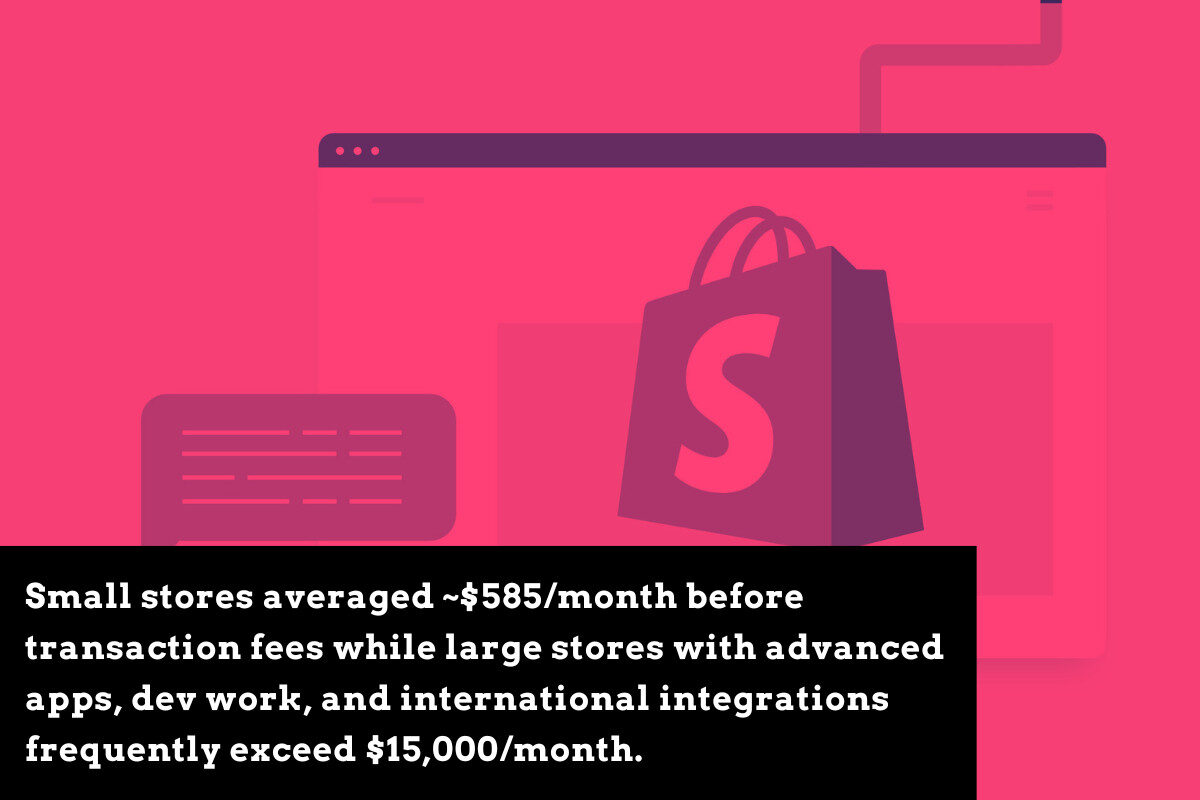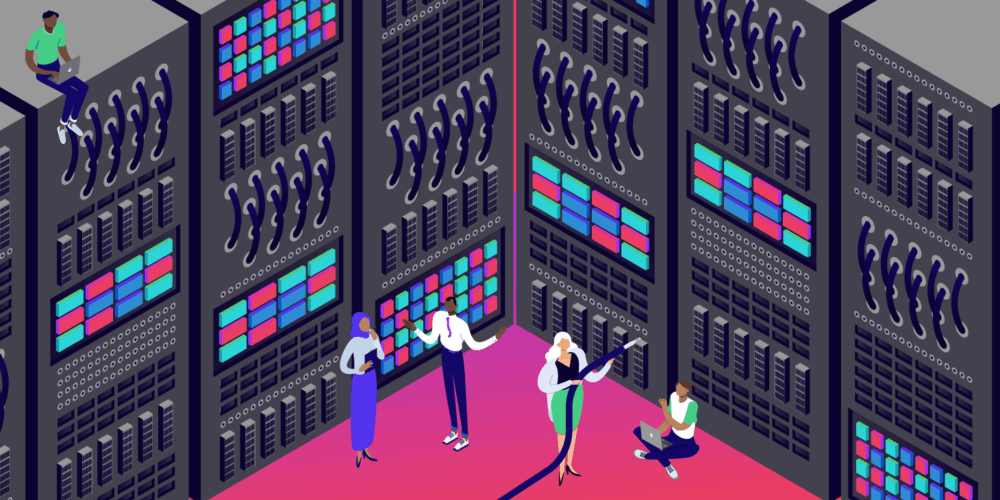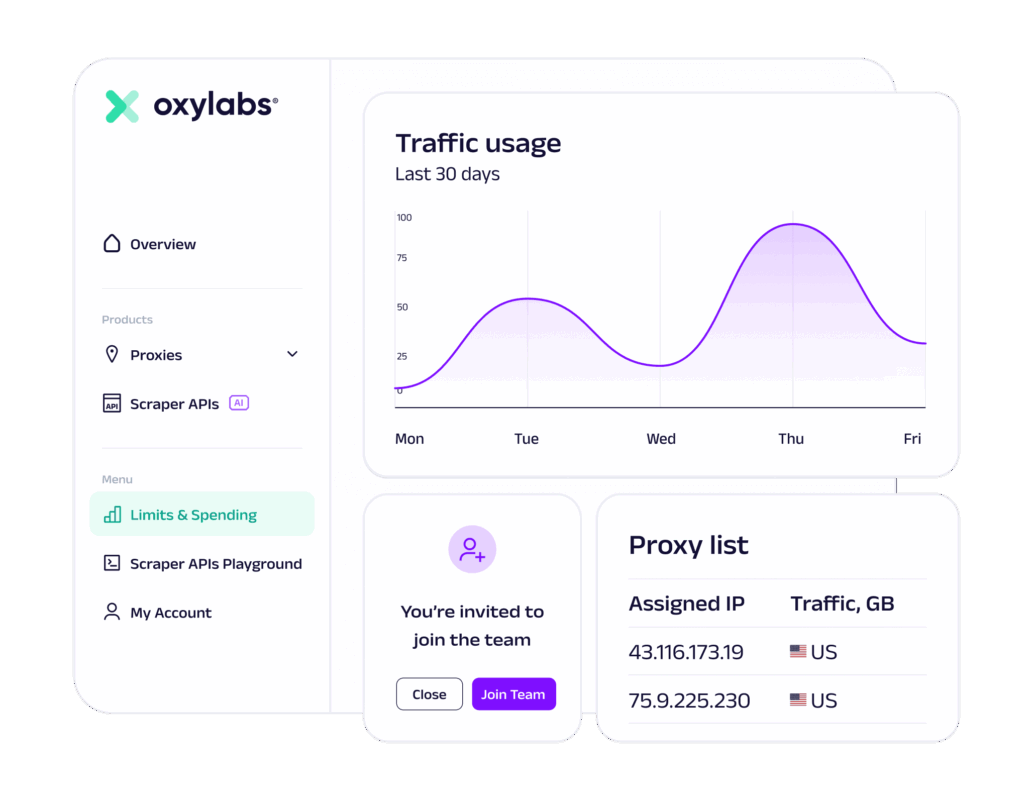Key Findings From Our Study 💰
- Average Shopify subscription spend: $29–$299/month, with Shopify Plus merchants averaging $2,000+/month.
- Apps are the hidden cost driver: Stores used between 6–10 apps on average, costing $450–$650 per month, often more than the Shopify plan itself.
- Domains remain minimal: Most stores pay $11–$18 per year, though premium domains cost significantly more.
- Transaction fees eat into margins: 2.4%–2.9% + $0.30 per order via Shopify Payments. Third-party gateways add another 0.5–2%.
- Essential SaaS tools (email, accounting, customer support) add $90–$150+ per month for most operators.
- Small stores averaged ~$585/month before transaction fees while large stores with advanced apps, dev work, and international integrations frequently exceed $15,000/month.
I’ve run a few Shopify stores and consulted on a bunch of others but I’ve never had a good idea about the average running costs of a typical Shopify store.
Shopify isn’t expensive to start with but anyone that’s run a store before knows that costs quickly mount up as you chase more and more sales and conversions.
So, what is the average running cost of a Shopify store? I wanted to know, so I decided to find out.
I reached out to a 20 store owners, all running Shopify stores, to find out more about their on-going costs, how much it costs them a month to run their business, and how it compares to their cash flow.
The results were eye-opening.
While Shopify’s base fee looks low, the “true cost” of running a professional store scales quickly once you add in apps, tools, and unavoidable transaction fees.
Everybody knows you have to run tools and apps on Shopify, it’s part of the process.
The dataset of stores I compiled covered a range of different sizes, from $5k a month stores to $100K+ a month. All agreed to discuss costs but only under the proviso that they could remain anonymous.
Core Costs Every Shopify Store Owner Faces
| Expense Type | Typical Cost (USD) | Notes |
|---|---|---|
| Shopify platform | $29–$299/month; Plus $2,000+ | Non-negotiable monthly fee |
| Domain purchase/renewal | $11–$18/year | Standard .com domains; premium much higher |
| Apps/plugins | Avg. $66.54 per app, 6–10 apps typical ($450–$650/month) | Email, reviews, loyalty, SEO, shipping |
| Transaction fees | 2.4%–2.9% + $0.30/order (Shopify Payments) | Extra 0.5–2% with 3rd-party gateway |
| Email marketing | $0–$50/month | Depends on subscriber count |
| Accounting software | $15–$40/month | QuickBooks, Xero, or equivalents |
| Customer service tools | $0–$60+/month per user | Helpdesk/live chat |
| Design tools | $0–$15/month | Canva, Adobe Express |
| Hosting & SSL | Included in Shopify | No extra cost |
Here’s How Much A $100K A Month Shopify Store Spends On Tools
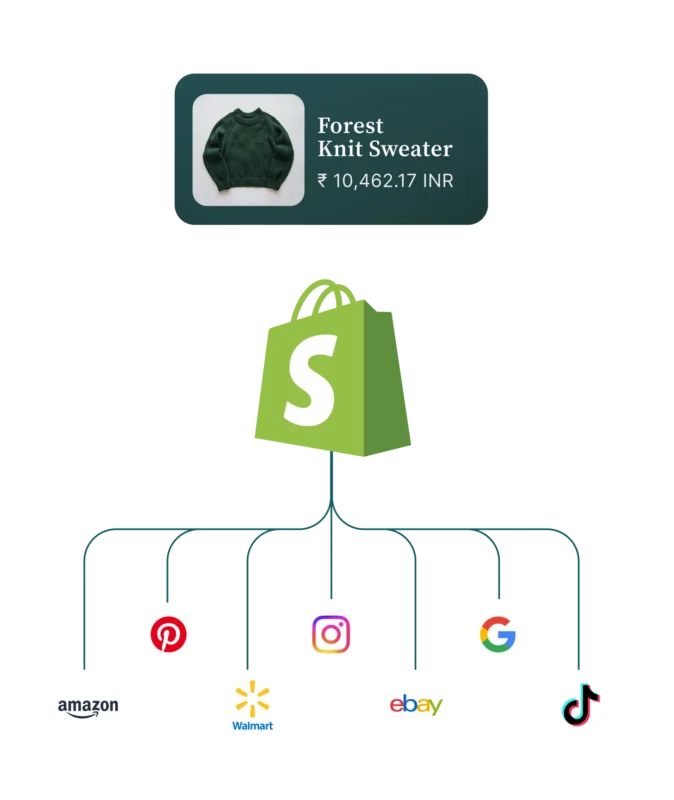
All of the stores from this study asked to remain anonymous, which I get. I wouldn’t want my competitors seeing how much I spend a month either. But whether you’re selling vapes or skincare products, B2C businesses tend to function in a similar way.
They all do email marketing, they do social, they do influencer marketing, they run SEO tools, loyalty programs, and they pay for apps that they hope will boost sales and improve conversion rates.
And this is the case for nearly all of the stores we spoke to; they all used similar tools and paid large amounts of cash for things like SEO tools and conversion-oriented apps to boost sales or aid in CRO efforts.
I’ve broken down the stores we spoke to into bite-sized chunks based on their average monthly revenue, starting with the smallest first.
Small/Medium Store (just getting started, less than $5K/month revenue)
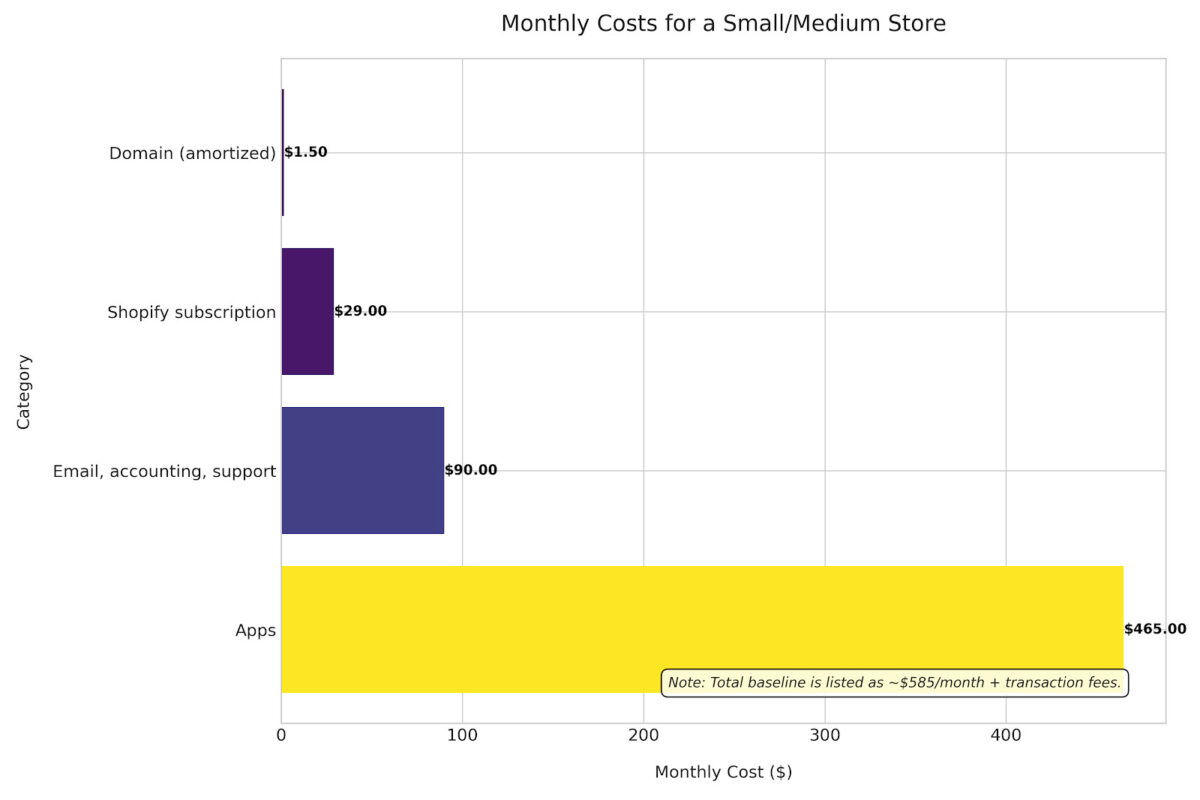
- Shopify subscription: $29
- Domain (amortized): $1.50/month
- Apps (7 apps on average): $465
- Email, accounting, support: $90
- Total baseline: ~$585/month + transaction fees
Even at this stage, apps and tools cost almost $500 a month.
Now, that’s only 10% of their revenue but it’s still a big number.
The lowest spent on tools in this revenue bracket was $150 and the highest was $800.
Also, there wasn’t too much difference between stores that made $5k a month and stores that made $10k a month with respect to monthly costs and cash spent on tools and apps.
Growing Store (established, $20K–$100K/month revenue)
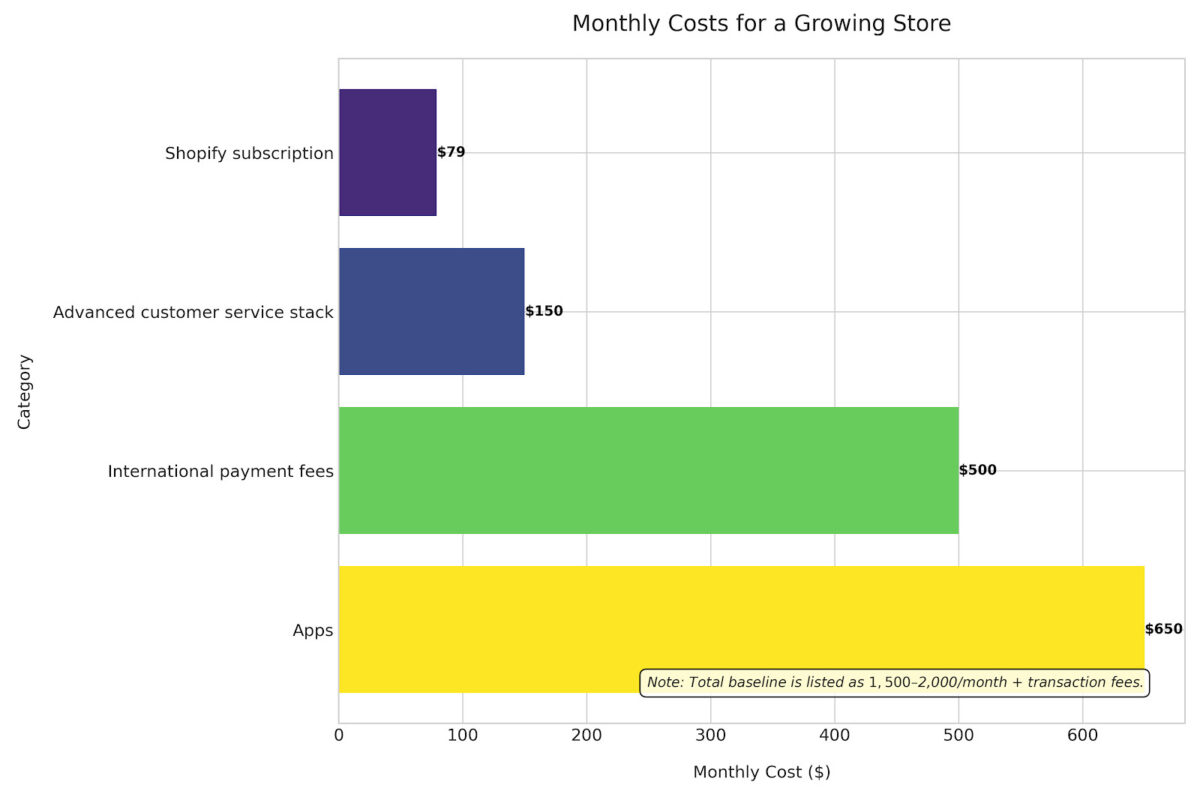
- Shopify subscription: $79–$299
- Apps (10–12 apps, including marketing automation): $650–$800
- Advanced customer service stack: $150+
- International payment fees: $500+
- Total baseline: $1,500–$2,000/month + transaction fees
This is the big leagues. Once you’re doing $20K+ a month, you’ve got yourself a very healthy little business.
And this is when costs, if you’re not careful, start to spiral.
You have plenty of cash coming in, so you start to speculate more freely on things (usually tools and apps) because your cash flow is solid, and this is where the bigger costs start showing up.
Most of the stores in this bracket were running three or more expensive apps, as well as enterprise-level versions of either SEMRush and Ahrefs.
Now, it’s true you will need some kind of SEO reporting tool to keep an eye on your store’s performance.
But you can get by with things like Google Search Console and Looker Studio for much less than a full-stack tool like Ahrefs or SEMRush.
I used SEMRush for years but I ditched my account earlier this year because, well… it was just too damn expensive.
It’s basically a car payment per month to run right now, and if you’re not using it to its fullest extent that’s just too much outlay.
Six-Figure Store (Shopify Plus, $100K+/month revenue)
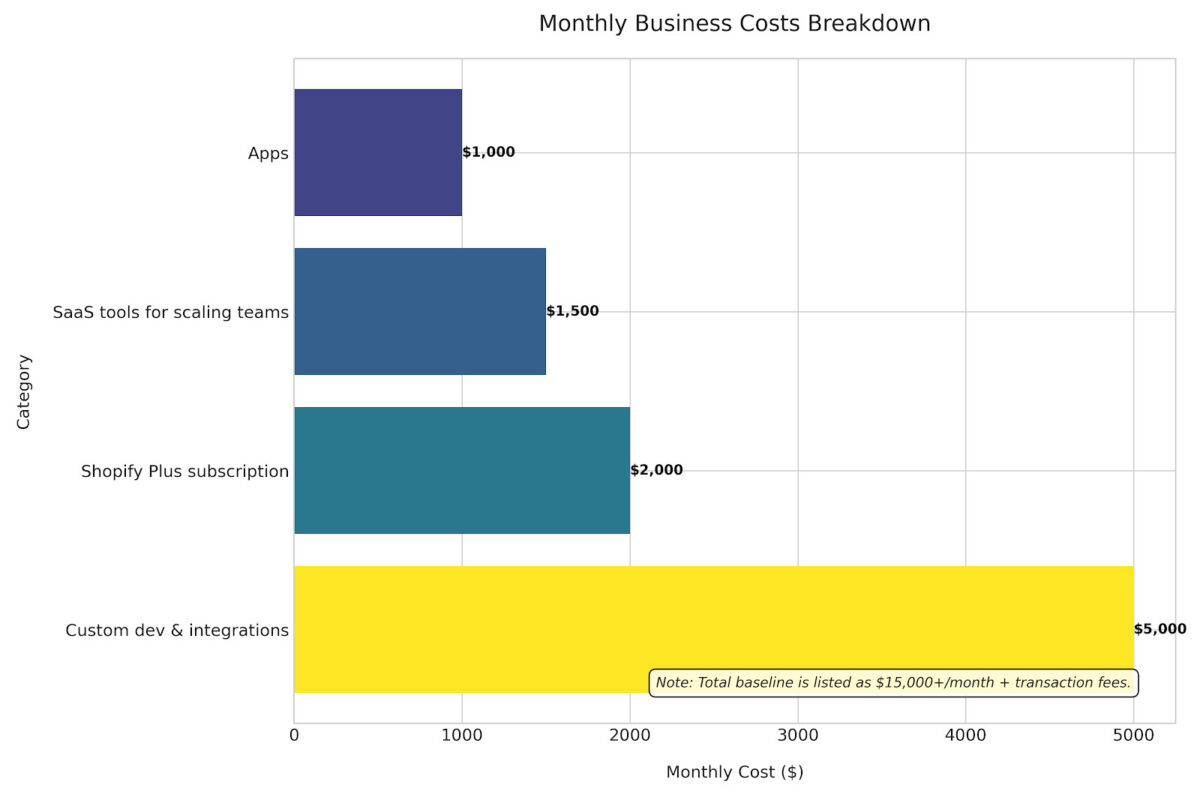
- Shopify Plus subscription: $2,000+
- Apps (10–15, often premium or custom): $1,000–$3,000
- Custom dev & integrations: $5,000+
- SaaS tools for scaling teams: $1,500+
- Total baseline: $15,000+/month + transaction fees
All of the six-figure stores we spoke to, with the exception of one, were running Shopify Plus which costs $2000+ a month.
In nearly cases, the premium subscription was warranted too; most of these stores were doing hundreds of orders per day.
That in itself is a major cost but it comes with a slew of benefits:
Key Benefits of Shopify Plus
- Scalability: 99.99% uptime, unlimited bandwidth, and support for 10,000+ checkouts per minute.
- Integrations: Higher API limits for real-time connections with ERP, OMS, and CRM systems.
- Checkout Control: Customizable checkout with upsells, branded fields, regional rules, and advanced discount/shipping logic.
- Conversion Gains: Shop Pay delivers up to 50% higher conversions compared to guest checkout.
Only top of this, most had pretty significant developer costs too; most were running custom builds, using next.js and Shopify’s Storefront API.
And all were running a combination of Shopify apps and SAAS tools that cost in excess of $200 a month each, driving up the average tools cost to close to $3500.
Which Shopify Apps Drove Up The Costs The Most?
All e-commerce stores spend money on tools. Everybody knows this. It is why the tools and app industry is churning out hundreds of billions of dollars in revenue every single quarter.
But what are the most useful Shopify apps? Which Shopify apps are the biggest stores using and why?
I had a separate question for this in the outreach email: What are the most important tools or Shopify apps you use?
Out of the 20 stores we spoke to, the following Shopify apps were cited as the most important and most integral, especially with larger stores:
- Analyzify (Advanced Analytics): One-time setup fee starting at $749, with additional charges for larger data needs and integrations.
- PageFly Landing Page Builder: Enterprise and unlimited plans reach $199/month, offering advanced design controls and premium support.
- AfterShip Premium: $239/month for enhanced shipment tracking, analytics, and automation—commonly adopted by high-volume brands.
- Loyalty Platforms (LoyaltyLion, Yotpo, etc.): Enterprise-tier plans often start at $199/month and scale higher with advanced features.
- Elevar (Tagging & Data Integrations): Entry plans begin at $200/month, with more complex setups costing significantly more.
When you factor in the cost of just these options, it’s easy to see how a single store can quickly clock up $3500+ in costs per month just for tools.
Add in a Shopify Plus subscription and you’re looking at $5500 just for tools and hosting your store.
Why Apps Drive Costs So Much

Our study found that apps are the single biggest variable cost across all store types.
From loyalty programs to reviews, email flows, advanced shipping, and upsell tools, newbie merchants often underestimate how quickly these subscriptions stack up.
But the key thing here is to remember that you don’t need all of them to scale; you can get away with the bare minimum when you’re starting.
For many operators, app spend surpasses the core Shopify fee (even with those that were Shopify Plus subscribers) which tells you everything you need to know about the insanely profitable world of Shopify apps and SAAS tools.
Bottom Line
Running a Shopify store in 2025 costs far more than the headline “$29/month” suggests.
Even lean operators pay hundreds per month, while growth-focused stores with advanced needs spend thousands.
The biggest takeaway from our study: budget realistically for apps, SaaS tools, and transaction fees, because those will define your real cost of doing business.
My advice? Never use a tool until it is completely essential, and when you do start using it you need to be constantly apprising it’s ROI.
If you’re paying $200 a month for something, it needs to generate twice that much in revenue otherwise it’s a sunk cost.
And if you’re thinking of getting into e-commerce, I’d still recommend Shopify over pretty much anything else.
WooCommerce while free at the point of use also relies heavily on tools and plugins to get it functional.
It’s also way more complicated to work with.
Shopify, at least for now, remains the best option for anyone looking to start out in e-commerce.
Just keep an eye on how much you’re spending on tools and apps…
